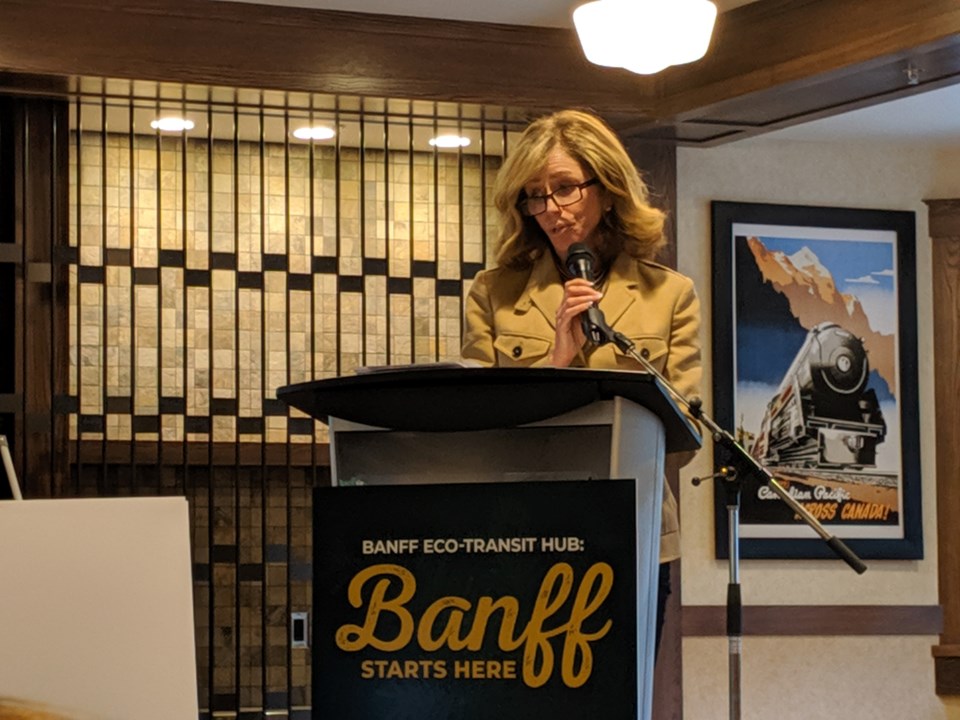BOW VALLEY – The provincial government is being lobbied to do a formal feasibility study on passenger rail from Calgary International Airport to Banff National Park.
Banff-Kananaskis MLA Miranda Rosin fired off a letter to provincial Transportation Minster Ric McIver on Feb. 11, which was signed by the municipalities of Banff and Cochrane as well as the Stoney Tribal administration and Banff train station owners Jan and Adam Waterous.
“With the mass influx of visitors in peak seasons, space is limited and our towns already struggle to accommodate the number of passenger vehicles coming through,” states the letter, which indicates land is secured and the regulatory process almost complete.
“We collectively believe that mass transit could be the best way to ensure we can continue moving tourists through these beautiful areas while also increasing new visitation by way of attraction using a beautiful coach line throughout the mountains.”
With 4.2 million visitors to Banff National Park each year, the Banff townsite and tourist hotspots such as Lake Louise and Moraine Lake have been experiencing congestion chaos, while other communities in the region continue to get busier as well.
An earlier feasibility study released in February 2019 determined all-year bus and/or rail mass transit was feasible, but couldn’t move forward without support from other levels of government because of the high costs.
That study, which was commissioned by Banff, Canmore, Cochrane, Calgary and Improvement District 9 estimated required capital costs for a train service would range from $660-$680 million. Operating costs, after fare revenue is considered, would be between $8.1-$9.1 million.
This compares to a bus service, which the study indicated would have capital costs ranging from $8.1 million to $19.6 million based on year-round scenarios. The operating costs for bus transit, after fare revenue is considered, would be about $2 to $2.3 million per year.
For passenger rail, the study put forward a scenario of eight round trips per day from Calgary to Banff in the summer and six in the winter. It calculated costs for both train and bus transit based on adult fares between $10 and $15.
In the 1980s, VIA operated between Calgary and Banff.
Canmore Mayor John Borrowman, while fully supporting the feasibility study for passenger rail, did not sign the letter sent by Rosin. Instead, he wrote a separate letter on behalf of Canmore town council.
He said he felt the general tone of the letter seemed quite strong on the proposed rail service, without reference to similar opportunities that could come with mass bus transit.
“The Town is not yet prepared to commit to rail service over bus transit until there’s a better understanding of environmental and financial impacts of both,” he said in a letter to Rosin.
In another letter to Alberta’s transportation minister, Borrowman listed a series of items that Canmore would like to see included in any feasibility study.
They include indirect capital and operating costs to communities along the route; anticipated impact to greenhouse gas emissions resulting from the rail service and how emissions may be mitigated; the preferred location for train stations, the costs associated with locating and connecting new stations, including land requirements, and the source of funding for the building, maintenance and operation.
In addition, Borrowman wanted research to consider effects to communities with increased passenger and freight rail traffic on a second line in the Canadian Pacific right-of-way. He also wanted consideration for bus service improvements as a bridge to a potential future rail system, among others.
“Given now that there is a rail project proposed, it is important that specific details be studied more closely in order to provide an informed basis for moving forward with rail as the preferred model,” Borrowman said.
Mayor Karen Sorensen signed the letter that Rosin sent to the provincial government this week.
“The Town of Banff continues to fully support Roam transit and the great success we’ve had with bus mass transit – and we want to continue to see that grow,” Sorensen said.
“With that being said, there is a concept out there to bring passenger rail back to Banff from Calgary, and if that is an option that different levels of government are exploring, then I’m happy to see them explore that further and see what it looks like.”
Jan and Adam Waterous, who under the umbrella of their personal financial holding company Liricon Capital have been spearheading the return of passenger rail, also signed onto the letter.
"Liricon continues to believe that the re-introduction of passenger rail will be integral to creating the green transit laboratory that we envision at the Banff Train Station," said Jan.
"Passenger rail, along with intercept parking and aerial transit to Norquay, will collectively help to pedestrianization Banff National Park and support the long-term ecological integrity of the region."
Meanwhile, an earlier study commissioned by Calgary Economic Development referenced on Rosin’s letter suggested that 84 per cent of people landing at Calgary airport with plans to travel to the mountains head directly to Banff, bypassing Calgary and surrounding communities.
That same study indicated that if there was a passenger railway line departing from the airport with a stop in downtown Calgary prior to heading to the Rockies, it could bring as much as $1 billion of economic impact to the city every year.
According to the letter sent to Alberta Transportation, that number doesn’t include the potential additional economic impact for the other communities of Banff, Canmore, Cochrane and Morley along the line.
“We are optimistic that this project could serve as a means to not only sustainability grow our tourism industry in Alberta, but also increase job opportunities, labour accessibility and mobility go Albertans along this route,” it stated.
Alberta Transportation did not respond to the Outlook’s request for comment.




